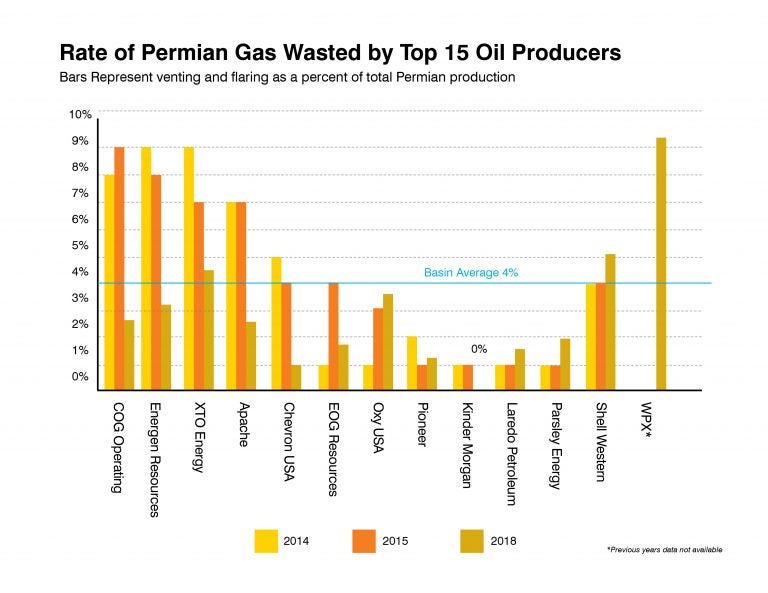 Texas’ Permian Basin isn’t just the site of the world’s biggest oil boom. It’s also the source of one of the country’s most unnecessary wastes of energy and associated air pollution. The burning off (flaring) and intentional release (venting) of natural gas has proven to be a black eye Permian producers can’t shake. A previous EDF analysis of 2014-2015 data found that operators in the Permian Basin flared and wasted more than 45 Bcf of natural gas in 2015 alone, enough to serve all 400,000 households in Texas Permian counties for two and a half years.
Texas’ Permian Basin isn’t just the site of the world’s biggest oil boom. It’s also the source of one of the country’s most unnecessary wastes of energy and associated air pollution. The burning off (flaring) and intentional release (venting) of natural gas has proven to be a black eye Permian producers can’t shake. A previous EDF analysis of 2014-2015 data found that operators in the Permian Basin flared and wasted more than 45 Bcf of natural gas in 2015 alone, enough to serve all 400,000 households in Texas Permian counties for two and a half years.
Production since then has boomed, and the Permian’s flaring problem has too. The burning off of associated gas is predicted to only get worse through 2019, and analysts predict the entire Permian Basin could flare as much as 1 Bcf a day in the coming year. That’s nearly four times the amount of gas produced by the Gulf of Mexico’s most productive gas facility.
EDF has recently analyzed the 2018 flaring data released by the Railroad Commission of Texas, the state’s oil and gas regulator, and beyond illustrating the scale of the problem – operators burned enough gas to serve all the heating and cooking needs of the state’s seven largest cities – the numbers tell us two main things:
First, many companies are flaring inexcusable amounts of natural gas.
You’d expect the basin’s largest producers to be its largest flarers. But that’s not entirely the case. A handful of companies that are nowhere near the top 15 producers make up an outsized share of the top 15 flarers.
Steward Energy II, for example, is the 60th largest producer, but it was the fourth largest flarer by volume (4.3 Bcf). Steward flared more natural gas than XTO Energy, despite the fact that XTO produced more than 10 times the amount of natural gas as Steward. How? Because Steward is flaring 64.5% of all the gas it produces, meaning that more than two-thirds of the natural gas the company pulled from the ground was flared and wasted.
Another company, Surge Operating LLC, flared 4.4 Bcf of natural gas, 22% of its total production and was the 3rd largest flarer. Jagged Peak Energy flared 19% of all the natural gas it produced – more than 3.5Bcf.
New Permian data show how worst offenders prevent progress on flaring Share on XSecond, the data suggest companies can reduce wasted energy and dangerous pollution.
As you can see in the chart below, some of the largest producers in the Permian appear to have improved their rate of flaring since our analysis of 2014-2015 data (the list of largest producers has shifted somewhat since 2015). That is some good news, and it demonstrates that individual companies are, in fact, able to reduce their flaring.
Those companies with low rates of flaring are probably implementing different strategies, including rigorous well and site design to minimize over-pressurization of tanks and takeaway gathering lines, as well as capital commitment and pre-planning to make sure wells either have access to pipelines or onsite strategies for using associated gas in operations.
But that potential good news is overshadowed by the blatant and excessive wastefulness of these other operators that flare an exceptionally high percentage of the natural gas they produce.
- Of the roughly 700 individual oil and gas operators in the region, 32 flared 100% of their produced volume. Every particle of natural gas they extracted was burned off and wasted.
- 41 operators flared more than 60% of the gas they extracted. Combined, they flared 7.2 Bcf of natural gas.
- 66 companies flared 20% or more of the natural gas they extracted. Combined, they burned and wasted 17.6 Bcf of product.
So, what does all of this mean?
Given the wide range of flaring rates and totals – and the amount of work required to interpret them – the Railroad Commission of Texas and the Texas Legislature should consider some simple changes to flaring policy and reporting requirements.
- Gas capture requirements for operators could dramatically reduce unnecessary flaring in the Permian by setting firm limits on the percentage of gas companies are allowed to flare across the basin. The limits would address the “worst actor” problem and could increase over time to give industry ample opportunity to adjust. For example, the RRC could require operators to capture 80% of all their gas by the end of 2020, 90% by 2021, etc. Without this sort of minimum performance standard, the state and Texans can only hope that companies do the right thing, while bad actors get a free ride and companies doing the right thing continue to be disadvantaged.
- The State of Texas should consider extending the existing gas production tax (7.5%) to flared gas. The concept is simple: put a price on the waste of natural gas. Under current state law, flared gas is exempt from the production tax, and each year the state is missing out on millions of dollars of tax revenue that’s going up in smoke.
Transparency is a significant motivator, and the Railroad Commission could do a lot more to modernize its operations and make flaring information easier to access and understand. Why, for example, should West Texas residents have to rely on a non-profit organization like EDF, or industry analytics firms, to collect and analyze production, flaring and pollution data? - Because the state is already collecting it, the Railroad Commission could produce a website to display up-to-date flaring data as soon as it is available. Further, the Commission should plan to keep pace with innovation and incorporate new data streams that will emerge, including satellite data.
As the oil and gas boom in the Permian Basin continues, this new data gives us some hope that responsible companies can and will make efforts to reduce flaring and the waste and pollution it produces. But it also shows us that other companies will exploit the dearth of rules around flaring until they’re forced to comply. We can’t simply count on the actions of a few responsible companies to clean up unnecessary pollution in the Permian.











